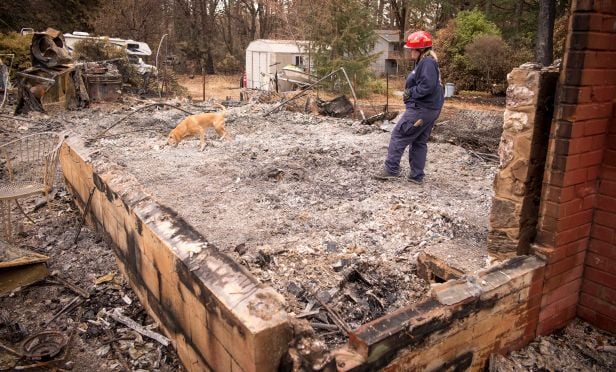 A search and rescue worker walks with a cadaver dog while looking for a missing person in Paradise, California, on Monday, Nov. 26, 2018. The nation's deadliest wildfire in a century known as the Camp Fire killed at least 85 people and burned over 14,000 homes. (Photo: David Paul Morris/Bloomberg)
A search and rescue worker walks with a cadaver dog while looking for a missing person in Paradise, California, on Monday, Nov. 26, 2018. The nation's deadliest wildfire in a century known as the Camp Fire killed at least 85 people and burned over 14,000 homes. (Photo: David Paul Morris/Bloomberg)
(Bloomberg Opinion) — Own a home? No doubt you've insured it. Very sensible of you. But if that home were, say, burned to the ground, then your insurance company probably wouldn't cover the cost of rebuilding it.
Don't feel too bad, though. It's only partly your fault.
|Estimates: 60-80% of policyholders are under-insured
Two-thirds of California wildfire victims are under-insured, according to Amy Bach, executive director of consumer advocacy group United Policyholders, speaking at a recent meeting of governor Gavin Newsom's wildfire commission, held in Santa Rosa. Shocking as that figure seems, it comports with anecdotes I picked up reporting on the aftermath of the recent wildfires earlier this year. Meanwhile, Sarah Paulson of Kevin Paulson Insurance Agency Inc. in San Diego, estimates maybe 60% of policyholders are under-insured.
Recommended For You
Want to continue reading?
Become a Free PropertyCasualty360 Digital Reader
Your access to unlimited PropertyCasualty360 content isn’t changing.
Once you are an ALM digital member, you’ll receive:
- Breaking insurance news and analysis, on-site and via our newsletters and custom alerts
- Weekly Insurance Speak podcast featuring exclusive interviews with industry leaders
- Educational webcasts, white papers, and ebooks from industry thought leaders
- Critical converage of the employee benefits and financial advisory markets on our other ALM sites, BenefitsPRO and ThinkAdvisor
Already have an account? Sign In Now
© 2025 ALM Global, LLC, All Rights Reserved. Request academic re-use from www.copyright.com. All other uses, submit a request to [email protected]. For more information visit Asset & Logo Licensing.








